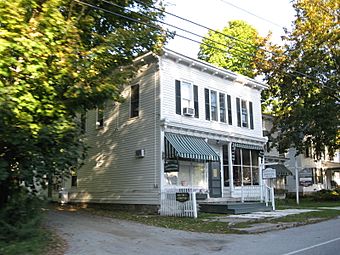Dorset Village Historic District facts for kids
|
Dorset Village Historic District
|
|

A shop in Dorset Village
|
|
| Location | Roughly bounded by Main and Church Sts. and Dorset Hollow Rd., and West Rd., Dorset, Vermont |
|---|---|
| Area | 158 acres (64 ha) (original) 75 acres (30 ha) (increase) |
| Architectural style | Federal, Late Victorian, Greek Revival |
| NRHP reference No. | 85000868 (original) 97000040 (increase) |
Quick facts for kids Significant dates |
|
| Added to NRHP | April 18, 1985 |
| Boundary increase | February 07, 1997 |
The Dorset Village Historic District is a special area in the heart of Dorset, Vermont. It's like a time capsule, showing how the village grew from the late 1700s to the early 1900s. You can find many old buildings and unique features here. For example, some sidewalks are made of beautiful marble from local quarries!
This historic district was added to the National Register of Historic Places in 1985. This means it's recognized as an important place in American history. Later, in 1997, the district was made even bigger to include more of the village.
Contents
What is the Dorset Village Historic District?
Dorset is a town located in northern Bennington County, Vermont. It sits within the Taconic Range. The village center is on the western side of the town. The main road, Vermont Route 30, runs through a valley.
The historic district is mostly found around the meeting point of Church Street, Kent Hill Road, and Route 30. Church Street goes west from Route 30, crossing a river to West Road. These two roads form the main part of the district.
What Can You See in the District?
In this area, you'll find many old buildings. There are several wooden shops and many houses from the 1800s. Some important public buildings include:
- The Congregational Church, which has a cool Gothic Revival style and is covered in marble.
- The Sykes Memorial Building, built around 1800, which is home to the Dorset Village Library.
One of the most interesting things to see is the marble sidewalks along Church Street. This marble came from some of Vermont's oldest marble quarries, right nearby! As you go further west on Church Street, the village becomes more spread out with more homes. There used to be a gristmill (a mill for grinding grain) near Prentiss Pond.
The district also includes the Dorset Golf Links. This is one of the oldest golf courses in the entire country, started way back in 1886!
A Glimpse into Dorset's Past
The town of Dorset was officially created in 1768. A very important meeting happened at Cephas Kent's tavern, about 2 miles (3 km) south of the village center. In 1777, people met there to discuss Vermont becoming independent. They wanted to be free from the claims of New York and New Hampshire.
Later that same year, the Vermont Republic was formed. This was like an independent country for Vermont. It operated on its own until 1791, when Vermont became the 14th state in the United States.
How Dorset Grew Over Time
Dorset first grew as a farming area. But it became much more important when marble from its quarries became very popular. This marble was used for many building projects all over the country.
However, the village center didn't grow as much in the 1800s. This was because it didn't have strong water power for factories. Also, it didn't get good train connections later on. Because of this, another part of town, East Dorset, became more important for a while.
Expanding the Historic District
When the Dorset Village Historic District was first added to the National Register in 1985, it only went as far west as Prentiss Pond. This was about halfway along Church Street.
But in 1997, the district was made larger. It now includes the homes west of the pond, all the way to West Road. It also stretches north and south along West Road for a bit. This expansion helps protect more of Dorset's historic buildings and unique character.



